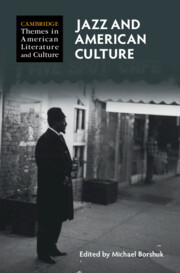Book contents
- Jazz and American Culture
- Cambridge Themes in American Literature and Culture
- Jazz and American Culture
- Copyright page
- Contents
- Contributors
- Acknowledgments
- Introduction
- Part I Elements of Sound and Style
- Part II Aesthetic Movements
- Part III Cultural Contexts
- Part IV Literary Genres
- Part V Images and Screens
- 18 “The Sound I Saw”
- 19 Love, Theft, and Transcendence
- 20 Reinstating Televisual Histories of Jazz
- 21 Documentary Jazz/Jazz Documentary
- 22 Two Dark Rooms
- Bibliography
- Index
18 - “The Sound I Saw”
Jazz and Visual Culture
from Part V - Images and Screens
Published online by Cambridge University Press: 09 November 2023
- Jazz and American Culture
- Cambridge Themes in American Literature and Culture
- Jazz and American Culture
- Copyright page
- Contents
- Contributors
- Acknowledgments
- Introduction
- Part I Elements of Sound and Style
- Part II Aesthetic Movements
- Part III Cultural Contexts
- Part IV Literary Genres
- Part V Images and Screens
- 18 “The Sound I Saw”
- 19 Love, Theft, and Transcendence
- 20 Reinstating Televisual Histories of Jazz
- 21 Documentary Jazz/Jazz Documentary
- 22 Two Dark Rooms
- Bibliography
- Index
Summary
By the end of the nineteenth century, cakewalk and ragtime music had taken the world so much by storm that Europe’s major classical composers were composing ragtime and cakewalk inspired music. Both Igor Stravinsky and Claude Debussy sought to break from European classical traditions by investing in the African American vernacular forms that were introducing the Old World to New World rhythmic patterns and melodies. This interest in performance, nightlife, the circus, and café culture was shared by artists such as Pablo Picasso, Francis Picabia, Charles Demuth, and George Grosz, all of whom explored themes and aesthetics influenced by the confluence of African American performance culture and African art available in the Western cultural capitals of Paris, New York, and Berlin. By the time author F. Scott Fitzgerald dubbed the 1920s “the jazz age” in the United States, African American music had already been influencing the trajectory of visual culture in the United States for several decades. With its creative fluidity, investment in aesthetics, and ability to mine African diasporic cultures for its most innovative impulses, jazz has been poised to respond to visual culture’s search for new vocabularies of form.
Keywords
- Type
- Chapter
- Information
- Jazz and American Culture , pp. 277 - 290Publisher: Cambridge University PressPrint publication year: 2023

